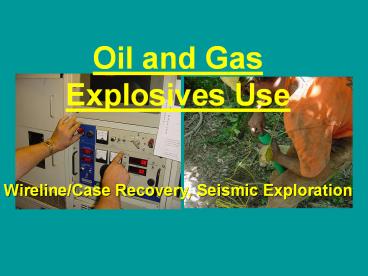Oil and Gas Explosives Use - PowerPoint PPT Presentation
Title:
Oil and Gas Explosives Use
Description:
Oil and Gas Explosives Use Wireline/Case Recovery, Seismic Exploration Requirements General All Oil and Gas explosives operations are covered by 25 PA Code Chapters ... – PowerPoint PPT presentation
Number of Views:132
Avg rating:3.0/5.0
Title: Oil and Gas Explosives Use
1
Oil and Gas Explosives Use
Wireline/Case Recovery, Seismic Exploration
2
Requirements General
- All Oil and Gas explosives operations are covered
by 25 PA Code Chapters 210 and 211 - 210 http//www.pacode.com/secure/data/025/chapte
r210/chap210toc.html - 211 http//www.pacode.com/secure/data/025/chapter
211/chap211toc.html
3
Requirements General
- All permit/license applications ask for ATF
permit or license s. - We share information with ATF and avoid
duplication of background checking.
4
Requirements Wireline/Case Recovery
- Explosive Storage Licenses
- Purchase/Sales
- Blasters License for Blasters-in-charge
Purchase/sales permits are required if
explosives are bought or sold in PA
5
(No Transcript)
6
Requirements Seismic Exploration
- Explosive Storage Licenses
- Purchase/Sales
- Blasters License for Blasters-in-charge
- Blasting Activity Permits
Purchase/sales permits are required if
explosives are bought or sold in PA
7
(No Transcript)
8
Explosives Storage ATF regulations (by reference)
are used to determine the amount and type of
explosives that can be stored in which type
magazines, and where magazines can be sited.
9
PA Explosives Security Regulations
- Outer Perimeter Security (Keeps out unauthorized
vehicles) - Inner Perimeter Security (Keeps out unauthorized
people) - Daily Inspections, enhanced notification, etc.
10
(No Transcript)
11
(No Transcript)
12
(No Transcript)
13
Purchase/Sales Permits
- Sales and Purchase Permits are combined if you
have both. - Used as a tracking mechanism.
14
Blasters License
- Anyone detonating explosives in Pennsylvania must
have a PA Blasters License - To obtain a PA Blasters License you must attend
the Departments 3 day training course. (Training
first 2 days, exam the morning of the 3rd) - The training focuses on regulations and
regulatory compliance in PA.
15
A limited Blasters License is required for oil
and gas explosives uses.
16
Blasting Activity Permits (BAPs)
- Required for Seismic Exploration
- Unlike wireline/case recovery operations
explosives charges on Seismic Exploration
operations are detonated near the surface and can
potentially affect structures and safety.
17
Seismic Exploration BAPs
- The Department needs sufficient information
(211.124(a)(15) to determine if the proposed
activity can be reasonably expected to meet the
regulatory requirements and may contain
conditions (211.124(c)(6) that ensure that the
activities will comply with regulations. - 300 foot setbacks from wells and houses to ensure
that the structures are not damaged and that the
reg limits for ppv, dBL will not be
exceeded. (211.151(c))
18
Seismic Exploration BAPs
- If the applicant proposes to go closer than 300
feet to a building we would require them to
conduct seismograph monitoring according to the
regulations and record ppv and dBL. If they
have done their own ppv, dBL studies we would
need to see that info. - We need to know how are they going to prevent
misfires. (Abandoning misfired explosives is
abandoning explosives (211.153(l)) - We will accept double capping. If one of the
seismic companies comes up with anything better
we all need to know.
19
Seismic Exploration BAPs
- We need to know what the applicant plans to do to
make the blast site safe if they have a
misfire. (211.157(d)) - The applicant will have to explain, for example,
that they will remove the misfired charge or
counter charge it. Entombing the charge or
letting it degrade are unacceptable. The
applicant needs a good misfire mitigation plan. - We need to know that the applicant will ensure
that no one can access or detonate the
charges. Explosives must not be left unattended
and the loaded blast be under observation of the
blaster 211.153(e), (f)
20
Seismic Exploration BAPs
- We need to know what the applicant plans to do to
make the blast site safe if they have a
misfire. (211.157(d)) - The applicant will have to explain, for example,
that they will remove the misfired charge or
counter charge it. Entombing the charge or
letting it degrade are unacceptable. The
applicant needs a good misfire mitigation plan. - We need to know that the applicant will ensure
that no one can access or detonate the
charges. Explosives must not be left unattended
and the loaded blast be under observation of the
blaster 211.153(e), (f)
21
Seismic Exploration BAPs
- In these operations the blasting cap wire leads
are usually buried so the applicant must explain
how the holes will be found and they have to
provide some sort of security while the charges
are in the ground. - We need to know where the holes
are. (211.133(1)) This could be part of what the
blaster-in-charge provides on a blast report with
the blaster's name, BL number, misfire info, if
needed, and any ppv,dBL info if needed - The regulations state that the Department can
specify stemming type and quantity (211.154(f)(7)
). The Department recommends that the applicant
state that they will use crushed stone on all
shallow holes, lt30 feet. This could go in the
comments section of the permit.
22
Seismic Exploration BAPs
- We want them to notify us when they are loading
and blasting. Otherwise we will not be able to
"determine compliance with applicable laws and
regulations." (211.124(a)(15)) - As for galvanometer use, how many drills each
blaster is responsible for etc., we can look at
that stuff when inspections are made.
(211.159(a), 211.211.154(a)) Actually, most of
the stuff in 211.141, 151, 153, 154, 155, 156,
157, and 159 appies to these operations.
23
(No Transcript)
24
Questions??































